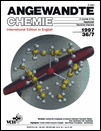A “Smart” Magnetic Resonance Imaging Agent That Reports on Specific Enzymatic Activity†
This research was supported by the Baxter Foundation, the Beckman Institute, and the NIH (AR42671). The authors thank Eric Ahrens and Russell Jacobs for helpful discussions and for assistance with the acquisition of MR images.
Graphical Abstract
A noninvasive means to map biological structure is offered by magnetic resonance imaging (MRI). A new class of MRI contrast agents is described where the relaxivity of the complex is modified by the activity of a specific enzyme (β-galactosidase, [Eq. (a)]). This type of agent offers the promise of direct three-dimensional visualization of gene expression in the form of an acquired MR image.





